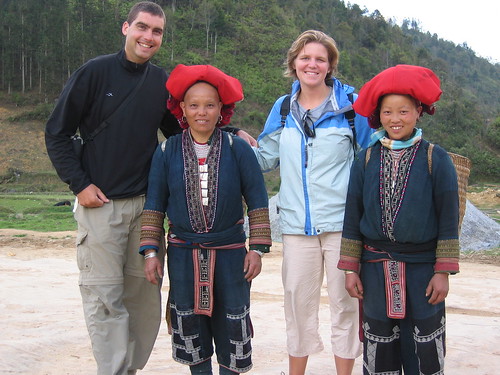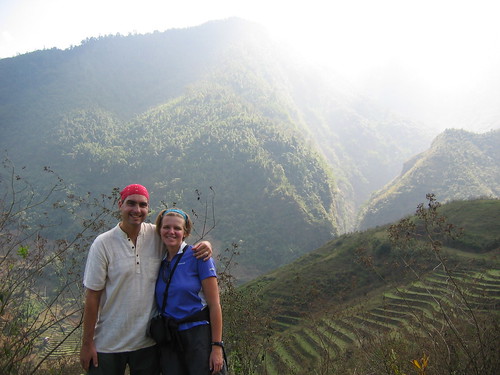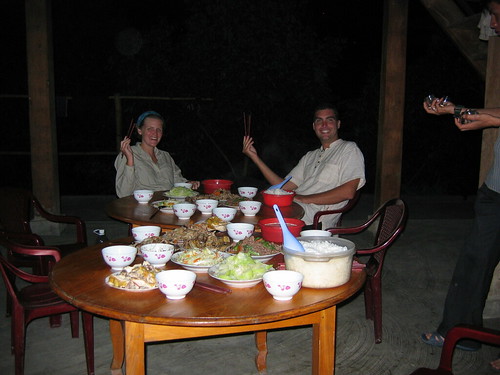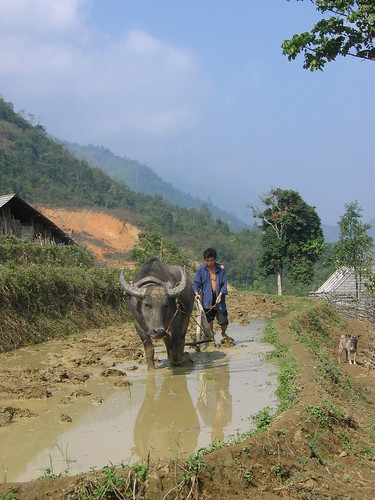We took an overnight sleeper train to the border town of Lao Cai (this is where you can look at China). We opted for the cheaper version of train (you can get on a tourist train for almost twice the cost). It turned out great - comfortable, soft sleeper beds (they sell hard sleeper beds as well, you can imagine why we didn't want that for the nine hour journey), no A/C, but the air is cool enough you don't need it, and with earplugs we were able to tune out the poker game next door. Our cabin slept four, and we were ecstatic to find that the other two beds weren't going to be occupied. Until 1:00 AM, when four more people were ushered in by the train attendant....two made themselves comfortable in one bed (and these are skinny beds), one in another, and one on the floor! It was so surreal, I couldn't open my mouth to comment, and Keith kindly just handed the gentleman on the floor his pillow. It ended up not being a big deal as they were all very quiet sleepers and were all smiles in the morning. Funny.
After arriving in Lao Cai, we had some more frustrating travel experiences to get ourselves to our destination of Sapa (when will this get easier?), but did finally get there before we got too annoyed (short version - minibus drives around Lao Cai for about an hour looking for more customers after cramming it full of grocery store items, then refuses to take us to our hotel after taking our money and asking us where we want to go, only to get dropped off in front of their friend's hotel...), and found a lovely hotel with a spectacular view.
Sapa sits at about 1600 meters and has stunning views of terraced rice fields and mountain peaks. The main tourist activity in Sapa is to go on treks to minority villages. The majority of Montagnards (people who live in hill-tribe communities) live in this region, and it is becoming quite the thing to go visit them, and even stay in their homes for a night. We were both uncomfortable with the idea as it felt a bit voyeuristic, but of course we did it anyway. It was very interesting to see how they live, and while we didn't get to any villages that were all that remote (even after promising us so), we still had a good experience. The villages we visited consisted of Black H'mong (black referring to the color of their clothes, not their skin), Tay, Zay, and Red Zao. Everyone works very, very hard in their rice fields and around their homes, and those that don't, spend their days in the streets of Sapa trying to sell tourists their goods.
The first day in Sapa, we rented a Russian Minsk, and explored the nearby roads and ended up at a Red Zao village. We were warmly greeted and quickly surrounded by about 7 lovely ladies. They were very charming and walked us around their village, spoke surprisingly good English and invited us into one of their homes. We knew as soon as we were surrounded, that we would have to buy something from them, but we were OK with it. There we are sitting in a very dark, yet spacious hut made of bamboo walls, and a dirt floor with a firepit for a stove drinking tea, when we finallly say we should be going, and yes we'd like to look at some of your things. The atmosphere instantly changed. We had embroidered handbags, money bags, hats, scarves, blankets literally thrown into our laps, with the ever-persistant plea to "please buy from me". No matter how many times we said we couldn't buy something from everyone, it didn't matter, the cries continued. We eventually got out of their buying only 3 small things, and lo-and-behold were not treated with quite the same hospitality on the way out of town. They were still smiling though. We asked them several times if they are happy that the tourists now come to their village so much, and they assured us that they like it very much. We asked several other people who are not villagers and they also say that the quality of life for everyone is better because of us. Hard to believe, because we feel like intruders and destroyers of their culture. But maybe we're just too idealistic.
Here we are after purchasing some handicrafts from these two Red Zao women. They shave their eyebrows and their foreheads and wear these cool hats.

The next day we took off on a two day guided trek. It ended up being just the two of us and we had a great, enthusiastic and very knowledgable guide. We learned all kinds of things about the way of life in that area, the government's influence on their agricultural techniques, Unicef's influence on the schools, and some about the plants and animals that we were walking through and amongst. Day 1 ended in a rather large village right on a river and a very nice homestay experience. This family actually has two buildings that they call home, one is set up completely for visitors/tourists. The homestay process has become quite organized, and we almost felt like we were at a rustic hotel. The home was again made of bamboo, but this time had a concrete floor and a separate room for the kitchen, where the stove still consisted of a bamboo lit fire. We helped/watched the preparations for dinner, which turned out to be a huge feast, then had a lively dinner with the guides (there was another small tour group staying there as well) and the family which involved a lot of homemade rice wine.
Some scenery on the way down to Ban Do village where we stayed the night:

Our feast! Notice the shot glasses in those hands in the right of the picture...and the ignorant smiles on our faces. We had no idea the trouble we were in.

Day 2 we visited another local village, then hiked ourselves back out of the valley and caught a ride back to Sapa in a Russian jeep. The villages were very interesting to see, but we wonder how much longer they will remain quaint and a novelty. Modern conveniences are slowly working their way in. We had refridgerated Coke, Tiger Beer, and bottled water waiting for us at the homestay, most homes have TV's and most villages are accessible by road (we only went to one village that would have required a Russian Minsk to drive to). But it is a peaceful life, and the people are indeed beautiful in all their custom jewlery and clothes.
Some of the hard work that takes place every day. These water buffalo are huge, yet very docile animals.

Yesterday we had yet another frustrating 2 hours working out transportation back to Hanoi, then spent the day around Lao Cai on motorbikes driving through some more beautiful mountainous scenery. Then boarded another night train back to Hanoi, arriving here at 4:50 AM. And here we have been killing time, and will board yet another night train tonight at 11:00 PM (unfortunately, this time it will be a hard sleeper). Next destination, Hue, right in the middle of Vietnam, just south of the DMZ (demilitarized zone).
More later!
No comments:
Post a Comment